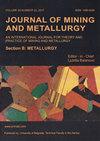Straight synthesis of α and γ alumina from kaolin by HCl acid leaching
IF 1
4区 材料科学
Q3 METALLURGY & METALLURGICAL ENGINEERING
Journal of Mining and Metallurgy Section B-Metallurgy
Pub Date : 2023-01-01
DOI:10.2298/jmmb230101017b
引用次数: 0
Abstract
This paper investigates the production of alumina from kaolinite by leaching method using hydrochloric acid. Raw kaolin was calcined at 850?C then leached with 6 M hydrochloric acid at 90?C, followed by the addition of 6 M HCl solution to the leachate the aluminum hydroxide was precipitated. Finally, precipitated aluminum hydroxide was heated at 1100?C and turned into aluminum oxide. Materials were identified by XRF, XRD and SEM-EDX techniques. Alumina recovery percentage was determined at different kaolin particle sizes (-200 to -400 standard Tyler screen mesh), different times (1, 2, 3 and 4 h), different leaching temperatures (80, 90, 100 and 104?C) and different concentrations of hydrochloric acid (20, 25, 30 and 37%). Alumina phase changes were also investigated at two calcination temperatures (1100 and 1200?C). The purity of aluminum oxide obtained from this process is about 97% and its recovery percentage is about 98%. It was observed that kaolin granulation with dimensions less than 75 ?m had no significant effect on alumina recovery percentage. It was also found that, the alumina recovery percentage increased with increasing leaching temperature.高岭土HCl酸浸法直接合成α和γ氧化铝
研究了以高岭石为原料,用盐酸浸出法制备氧化铝的工艺。生高岭土在850℃下煅烧。然后用6m盐酸在90℃下浸出。C,然后在渗滤液中加入6 M HCl溶液沉淀氢氧化铝。最后,将沉淀的氢氧化铝加热到1100℃。C变成氧化铝。采用XRF、XRD和SEM-EDX技术对材料进行了表征。测定了不同高岭土粒径(-200 ~ -400标准泰勒筛目)、不同浸出时间(1、2、3、4 h)、不同浸出温度(80、90、100、104℃)和不同盐酸浓度(20、25、30、37%)下氧化铝的回收率。在1100℃和1200℃两种煅烧温度下,研究了氧化铝的相变化。该工艺制得的氧化铝纯度约为97%,回收率约为98%。研究发现,粒径小于75 μ m的高岭土造粒对氧化铝回收率无显著影响。氧化铝回收率随浸出温度的升高而增加。
本文章由计算机程序翻译,如有差异,请以英文原文为准。
求助全文
约1分钟内获得全文
求助全文
来源期刊
CiteScore
2.00
自引率
40.00%
发文量
19
审稿时长
2 months
期刊介绍:
University of Belgrade, Technical Faculty in Bor, has been publishing the journal called Journal of Mining and Metallurgy since 1965 and in 1997 it was divided in two independent journals dealing with mining and metallurgy separately. Since 2009 Journal of Mining and Metallurgy, Section B: Metallurgy has been accepted in Science Citation Index Expanded.
Journal of Mining and Metallurgy, Section B: Metallurgy presents an international medium for the publication of contributions on original research which reflect the new progresses in theory and practice of metallurgy. The Journal covers the latest research in all aspects of metallurgy including hydrometallurgy, pyrometallurgy, electrometallurgy, transport phenomena, process control, solidification, mechanical working, solid state reactions, materials processing, surface treatment and relationships among processing, structure, and properties of materials.

 求助内容:
求助内容: 应助结果提醒方式:
应助结果提醒方式:


